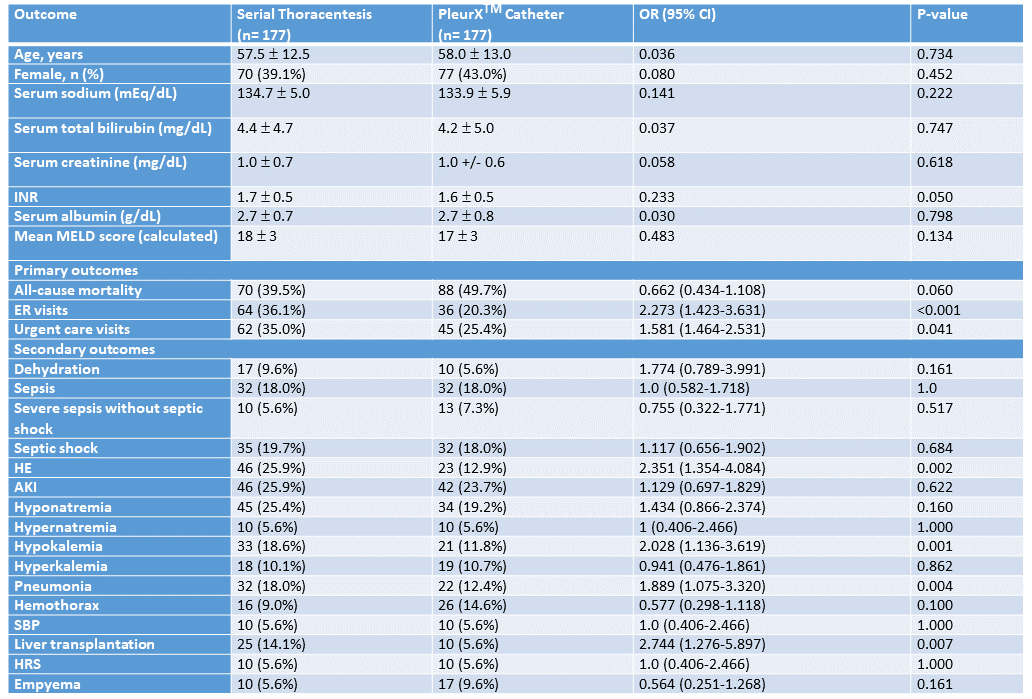Oral Paper Presentation
Annual Scientific Meeting
Session: Plenary Session 3A: Liver / Functional
38 - Indwelling Pleural Catheter as a Safe and Convenient Alternative to Serial Thoracentesis for the Management of Hepatic Hydrothorax: A Retrospective Propensity-Matched Cohort Study
Tuesday, October 28, 2025
2:25 PM - 2:35 PM PDT
Location: North Ballroom 120D

Azhar Hussain, MBBS
SUNY Upstate Medical University Hospital
Syracuse, NY
Presenting Author(s)
Azhar Hussain, MBBS1, Savio John, MD, FACG2, Kevin Thomas, MD3, Ahmad Nawaz, MBBS2, Manju Paul, MD4
1SUNY Upstate Medical University Hospital, Syracuse, NY; 2SUNY Upstate Medical University, Syracuse, NY; 3SUNY Upstate - - Syracuse, NY - 750 East Adams StSyracuse, NY 13210UNITED STATES - Syracuse, NY, Syracuse, NY; 4SUNY Upstate, Syracuse, NY
Introduction: Serial thoracentesis is an established management strategy for hepatic hydrothorax (HH) patients who are intolerant to diuretics or not candidates for transjugular intrahepatic portosystemic shunt (TIPS) placement, but it carries a risk of complications. The role of indwelling pleural catheters (IPCs), such as the PleurXTM catheter, in HH management remains controversial. This study aims to evaluate the safety and efficacy of PleurXTM catheters compared to serial thoracentesis in patients with HH.
Methods: We conducted a retrospective, propensity-matched cohort study using U.S. population-based data, aged 18–89 years with HH secondary to cirrhosis of any etiology. Exclusion criteria included malignancy, congestive heart failure, nephrotic syndrome, chronic kidney disease, TIPS placement, or pleural effusions due to causes other than hepatic hydrothorax.
Patients were stratified into two cohorts: (1) HH managed with PleurXTM catheter placement and (2) HH managed with serial thoracentesis. After 1:1 propensity score matching, multivariate regression analysis was performed to evaluate primary and secondary outcomes over 18 months following the index intervention.
Results: All-cause mortality at 18 months was comparable between the PleurXTM and serial thoracentesis cohorts (odds ratio [OR] 0.662, 95% confidence interval [CI] 0.434 - 1.108). However, patients in the serial thoracentesis group demonstrated higher odds of emergency room visits (OR 2.273, 95% CI 1.423 - 3.631), urgent care visits (OR 1.581, 95% CI 1.464 - 2.531), hepatic encephalopathy (OR 2.351, 95% CI 1.354-4.084), pneumonia (OR 1.889, 95% CI 1.075–3.320), liver transplantation (OR 2.744, 95% CI 1.276–5.897), and hypokalemia (OR 2.028, 95% CI 1.136–3.619) compared to the PleurXTM cohort (Table 1).
Discussion: To the best of our knowledge, this is the largest US population-based study directly comparing the impact of PleurXTM catheters versus serial thoracentesis in patients with pleural effusions secondary to liver cirrhosis. Our data concluded that PleurXTM catheter placement was associated with a lower risk of emergency room and urgent care visits, hepatic encephalopathy, pneumonia, hypokalemia, and reduced need for liver transplantation compared to serial thoracentesis in patients with HH. Careful patient selection and close monitoring remain critical for optimizing outcomes in patients undergoing indwelling pleural catheter placement.

Figure: Table 1: Baseline clinical characteristics, primary and secondary outcomes among serial thoracentesis vs. pleurX catheter in hepatic hydrothorax at 18 months post-intervention.
Disclosures:
Azhar Hussain indicated no relevant financial relationships.
Savio John indicated no relevant financial relationships.
Kevin Thomas indicated no relevant financial relationships.
Ahmad Nawaz indicated no relevant financial relationships.
Manju Paul indicated no relevant financial relationships.
Azhar Hussain, MBBS1, Savio John, MD, FACG2, Kevin Thomas, MD3, Ahmad Nawaz, MBBS2, Manju Paul, MD4, 38, Indwelling Pleural Catheter as a Safe and Convenient Alternative to Serial Thoracentesis for the Management of Hepatic Hydrothorax: A Retrospective Propensity-Matched Cohort Study, ACG 2025 Annual Scientific Meeting Abstracts. Phoenix, AZ: American College of Gastroenterology.
1SUNY Upstate Medical University Hospital, Syracuse, NY; 2SUNY Upstate Medical University, Syracuse, NY; 3SUNY Upstate - - Syracuse, NY - 750 East Adams StSyracuse, NY 13210UNITED STATES - Syracuse, NY, Syracuse, NY; 4SUNY Upstate, Syracuse, NY
Introduction: Serial thoracentesis is an established management strategy for hepatic hydrothorax (HH) patients who are intolerant to diuretics or not candidates for transjugular intrahepatic portosystemic shunt (TIPS) placement, but it carries a risk of complications. The role of indwelling pleural catheters (IPCs), such as the PleurXTM catheter, in HH management remains controversial. This study aims to evaluate the safety and efficacy of PleurXTM catheters compared to serial thoracentesis in patients with HH.
Methods: We conducted a retrospective, propensity-matched cohort study using U.S. population-based data, aged 18–89 years with HH secondary to cirrhosis of any etiology. Exclusion criteria included malignancy, congestive heart failure, nephrotic syndrome, chronic kidney disease, TIPS placement, or pleural effusions due to causes other than hepatic hydrothorax.
Patients were stratified into two cohorts: (1) HH managed with PleurXTM catheter placement and (2) HH managed with serial thoracentesis. After 1:1 propensity score matching, multivariate regression analysis was performed to evaluate primary and secondary outcomes over 18 months following the index intervention.
Results: All-cause mortality at 18 months was comparable between the PleurXTM and serial thoracentesis cohorts (odds ratio [OR] 0.662, 95% confidence interval [CI] 0.434 - 1.108). However, patients in the serial thoracentesis group demonstrated higher odds of emergency room visits (OR 2.273, 95% CI 1.423 - 3.631), urgent care visits (OR 1.581, 95% CI 1.464 - 2.531), hepatic encephalopathy (OR 2.351, 95% CI 1.354-4.084), pneumonia (OR 1.889, 95% CI 1.075–3.320), liver transplantation (OR 2.744, 95% CI 1.276–5.897), and hypokalemia (OR 2.028, 95% CI 1.136–3.619) compared to the PleurXTM cohort (Table 1).
Discussion: To the best of our knowledge, this is the largest US population-based study directly comparing the impact of PleurXTM catheters versus serial thoracentesis in patients with pleural effusions secondary to liver cirrhosis. Our data concluded that PleurXTM catheter placement was associated with a lower risk of emergency room and urgent care visits, hepatic encephalopathy, pneumonia, hypokalemia, and reduced need for liver transplantation compared to serial thoracentesis in patients with HH. Careful patient selection and close monitoring remain critical for optimizing outcomes in patients undergoing indwelling pleural catheter placement.

Figure: Table 1: Baseline clinical characteristics, primary and secondary outcomes among serial thoracentesis vs. pleurX catheter in hepatic hydrothorax at 18 months post-intervention.
Disclosures:
Azhar Hussain indicated no relevant financial relationships.
Savio John indicated no relevant financial relationships.
Kevin Thomas indicated no relevant financial relationships.
Ahmad Nawaz indicated no relevant financial relationships.
Manju Paul indicated no relevant financial relationships.
Azhar Hussain, MBBS1, Savio John, MD, FACG2, Kevin Thomas, MD3, Ahmad Nawaz, MBBS2, Manju Paul, MD4, 38, Indwelling Pleural Catheter as a Safe and Convenient Alternative to Serial Thoracentesis for the Management of Hepatic Hydrothorax: A Retrospective Propensity-Matched Cohort Study, ACG 2025 Annual Scientific Meeting Abstracts. Phoenix, AZ: American College of Gastroenterology.

